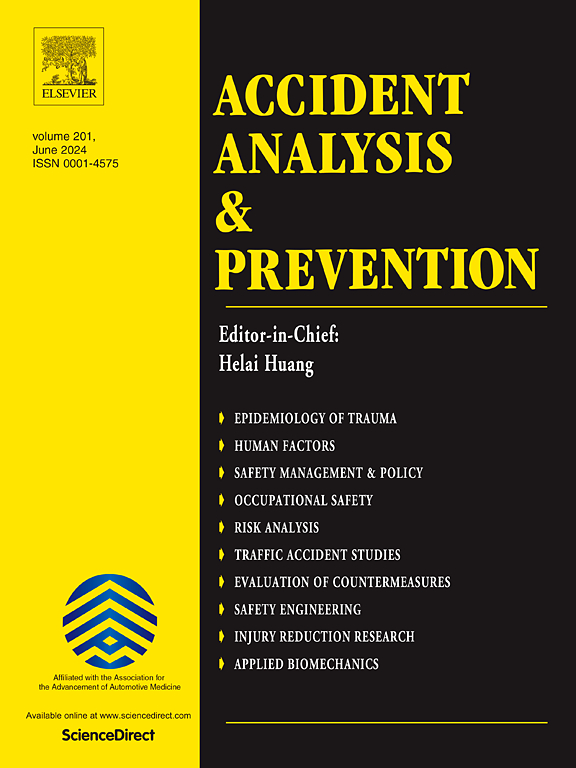Comparative safety analysis of take-over control mechanisms of conditionally automated vehicles
IF 5.7
1区 工程技术
Q1 ERGONOMICS
引用次数: 0
Abstract
Conditionally Automated driving (CAD) represents a pivotal point in the evolution of automotive technology, bridging full automation and human intervention through effective control mechanisms that ensure safe driver-system transitions. This research consisted of a comparative analysis of take-over mechanisms, focusing on ordinary merging and diverging maneuvers and critical collision-avoidance scenarios. Three take-over control (TOC) methods, including (i) accelerating/braking, (ii) pressing a dedicated button, and (iii) steering, were investigated. Thirty participants were recruited using a mixed factorial design with both within- and between-subject factors. The experimental simulations were conducted on the fixed-base driving simulator. The participants completed three runs on a motorway track comprising ordinary merging and diverging sections, with the final run involving a sudden critical decision to avoid the collision against two crashed vehicles. Weibull accelerated failure time models with and without shared frailty, mixed effects linear regression and multiple linear regression were used to model TOC time, maximum resultant acceleration, and minimum time to collision values.
The results indicate that the pedal mechanism generally provides faster and safer takeovers, especially in critical situations, while the button mechanism results in the longest TOC times, and lowest minimum time to collision values, indicating higher risks. The steering wheel mechanism, associated with the highest maximum resultant acceleration and TOC times in merging and diverging maneuvers, suggests that lateral control may be more cognitively demanding for drivers. These findings emphasize the importance of selecting appropriate TOC mechanisms to improve the safety and efficiency of CAD systems.
条件自动驾驶车辆接管控制机制的安全性比较分析
有条件自动驾驶(CAD)代表了汽车技术发展的一个关键点,它通过有效的控制机制将完全自动化和人为干预连接起来,确保驾驶员系统的安全过渡。本研究包括接管机制的比较分析,重点是普通合并和分散机动和关键避碰场景。三种接管控制(TOC)方法,包括(i)加速/制动,(ii)按专用按钮,(iii)转向,进行了研究。采用混合因子设计招募了30名参与者,其中既有受试者内部因素,也有受试者之间因素。在固定基座驾驶模拟器上进行了实验仿真。参与者在一条高速公路上完成了三次跑步,其中包括普通的合并和分流路段,最后一次跑步涉及到一个突然的关键决定,以避免与两辆撞车的车辆相撞。采用Weibull加速失效时间模型,混合效应线性回归和多元线性回归对TOC时间、最大合成加速度和最小碰撞时间进行建模。结果表明,踏板机构通常提供更快,更安全的接管,特别是在关键情况下,而按钮机构的TOC时间最长,碰撞值的最小时间最短,表明风险更高。方向盘机制与合并和分散操作中最大的最终加速度和TOC时间有关,表明横向控制可能对驾驶员的认知要求更高。这些发现强调了选择合适的TOC机制对于提高CAD系统的安全性和效率的重要性。
本文章由计算机程序翻译,如有差异,请以英文原文为准。
求助全文
约1分钟内获得全文
求助全文
来源期刊

Accident; analysis and prevention
Multiple-
CiteScore
11.90
自引率
16.90%
发文量
264
审稿时长
48 days
期刊介绍:
Accident Analysis & Prevention provides wide coverage of the general areas relating to accidental injury and damage, including the pre-injury and immediate post-injury phases. Published papers deal with medical, legal, economic, educational, behavioral, theoretical or empirical aspects of transportation accidents, as well as with accidents at other sites. Selected topics within the scope of the Journal may include: studies of human, environmental and vehicular factors influencing the occurrence, type and severity of accidents and injury; the design, implementation and evaluation of countermeasures; biomechanics of impact and human tolerance limits to injury; modelling and statistical analysis of accident data; policy, planning and decision-making in safety.
 求助内容:
求助内容: 应助结果提醒方式:
应助结果提醒方式:


